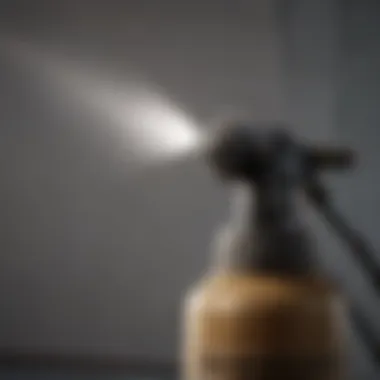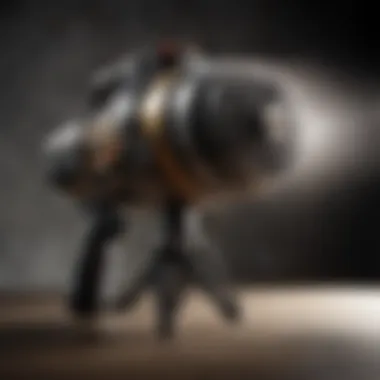Understanding the Fan Tip Sprayer: A Comprehensive Guide


Intro
In the realm of home improvement, achieving a smooth, even coat when painting or applying treatments can sometimes feel like a Sisyphean task. Enter the fan tip sprayer. This device has revolutionized the way homeowners engage with paint, solvents, and other liquids, offering both efficiency and precision. But what exactly is a fan tip sprayer, and why is it gaining traction among DIY enthusiasts and professionals alike?
Overview of Topic
A fan tip sprayer is designed to create a wide, even spray pattern, efficiently covering surfaces of varying textures and shapes. The key to its function lies in its nozzle shape, which disperses the fluid into a fan-like shape. This allows for better coverage, reducing the number of strokes and time spent on the job. In applications ranging from interior painting to agricultural spraying, the benefits of a fan tip sprayer are hard to overlook.
Why is this topic crucial for homeowners? In today’s fast-paced world, a well-executed paint job or treatment application can significantly enhance a home’s aesthetic appeal and increase its value. Furthermore, selecting the right tools and techniques can prevent headaches down the line—like paint drips or uneven finishes that require additional touch-ups. The fan tip sprayer emerges as a strategic solution to these frequent issues, offering an effective means to achieve both speed and style in home improvement projects.
Common Challenges and Solutions
While employing a fan tip sprayer can undoubtedly elevate a project, it does come with its unique set of hurdles.
- Challenge: Inefficient spray pattern or uneven application.
- Challenge: Clogging of the nozzle during use.
- Challenge: Difficulty in achieving consistent pressure for an even finish.
- Solution: Make sure the nozzle is adjusted correctly and practice in a location where mistakes won't show. Properly thinning your paint can also help achieve a finer spray.
- Solution: Regularly clean the nozzle during prolonged tasks. Keeping your paint free of debris and using filter systems can prevent clogs.
- Solution: Understanding your sprayer’s settings and maintaining a steady distance from the surface will lead to better consistency. Investing in a quality air compressor can help maintain pressure.
“The right tools not only make the job easier, but they also ensure a professional finish.”
Product Recommendations
The market boasts several brands that deliver quality fan tip sprayers for home use. Here’s a closer look:
- Graco Magnum X5: This sprayer is ideal for homeowners tackling medium to large projects. Its adjustable pressure settings adapt to different materials allowing for a customizable experience.
- Wagner Control Pro 150: A reliable option featuring airless technology that reduces overspray and helps control materials effectively. Plus, it's lightweight and easy to maneuver.
- Titan Impact 440: Known for its durability and versatility, this sprayer can handle residential projects with ease and is often favored by professionals.
When considering these products, think about the type of projects you plan to undertake and match the sprayer’s capabilities accordingly.
Step-by-Step Guides
To get the most out of your fan tip sprayer, follow these basic steps when beginning a painting project:
- Prepare the Surface: Clean and repair any imperfections on the surface you’ll be painting.
- Select Proper Material: Choose paint or liquid suited for your project. Thinning may be necessary depending on the material.
- Adjust the Settings: Set the nozzle to the appropriate spray pattern. Test it on a cardboard piece before starting.
- Spray Technique: Maintain a consistent distance of about 12 to 18 inches from the surface. Move in steady strokes, overlapping slightly with each pass.
- Clean-Up: After completing the project, thoroughly clean your sprayer as per the manufacturer’s instructions. Leaving paint in the system can lead to clogs and damage.
Implementing these steps properly can mean the difference between a laborious, frustrating job and a sleek, efficient application.
Prelude to Fan Tip Sprayers
The landscape of spraying tools has evolved significantly, and fan tip sprayers have carved out a niche for themselves in various applications. These sprayers, notable for their unique nozzle design, disperse liquids in a thin, even fan pattern. This ability to spread product uniformly is just one of the reasons why understanding fan tip sprayers is essential for anyone operating in fields like painting, agriculture, or even DIY home projects.
As we delve into the heart of fan tip sprayers, it's critical to underscore their impact on efficiency and effectiveness. By choosing the right sprayer and mastering its usage, professionals and enthusiasts alike can achieve high-quality finishes while optimizing their workflows. This guide not only reveals the mechanics and components but also illustrates how to use these sprayers to their full potential.
Defining Fan Tip Sprayers
Fan tip sprayers are specialized devices that utilize a fan-shaped spray pattern. Unlike conventional nozzles that create a circular pattern, fan tip sprayers distribute liquid in a wide, flat sheet. This is particularly advantageous for applications requiring coverage over larger areas, such as painting walls or spraying crops.
The distinguishing characteristic of a fan tip sprayer is its nozzle. The nozzle design influences the pattern of the spray, the droplet size, and the distance the liquid can travel. For instance, a narrower fan can yield finer control, ideal for intricate jobs, while a wider fan can cover more ground swiftly.
The Importance of Sprayer Technology
In today’s fast-paced world, the technology behind sprayers is more aligned with user demands than ever. The evolution from simpler spraying tools to advanced fan tip sprayers reflects larger trends toward efficiency and precision.
Key reasons to appreciate this technology include:
- Precision Application: Reduced overspray helps save materials and increases accuracy, which is crucial for costly projects.
- Versatile Use Cases: From agriculture to home improvement, these sprayers can handle a multitude of liquid types, including paint, pesticides, and cleaning solutions.
- Enhanced Efficiency: Modern designs allow for faster application times, enabling users to cover more in less time without sacrificing quality.
"Technology isn’t just about gadgets; it’s about improving processes and making them more effective."
By grasping the definition and importance of fan tip sprayers, users can better navigate their choices and apply the tools effectively. With this foundation, the journey into the intricate details of these sprayers can truly begin.
Components of Fan Tip Sprayers
Understanding the components of fan tip sprayers is crucial for making informed choices about their use in various applications. The intricate construction and diverse functionalities of these sprayers can greatly influence the quality and efficiency of spraying tasks. Let's break down the essential elements.
Sprayer Body and Construction
The sprayer body serves as the backbone of any fan tip sprayer, built to endure the rigors of daily use while facilitating effective application. The body is typically designed with ergonomics in mind, allowing for a comfortable grip and ease of maneuverability. Materials such as plastic or metal are common, each offering distinct advantages. For instance, plastic bodies are lightweight and resistant to corrosion, making them suitable for frequent use in outdoor settings.
Moreover, the construction of the body also impacts the sprayer's durability. Features like reinforced seams or rubberized grips contribute to an overall robust design. This not only enhances longevity but also reduces the likelihood of spills or leaks during use. The choice of construction is paramount—after all, a sturdy sprayer can mean the difference between a smooth application job and a frustrating experience.


Types of Fan Tips
Fan tips significantly influence the spray pattern and coverage area. These tips determine how liquid is atomized and propelled, resulting in different application techniques. For example, narrower tips produce a fine mist suitable for delicate jobs like flower beds, whereas wider tips create a heavier spray that covers larger surfaces efficiently. Understanding these differences can help users select the right type for their specific needs.
Here are some common types of fan tips:
- Hollow cone: Often used in agricultural spraying, this type provides a concentrated spray that penetrates deeper foliage.
- Solid cone: Ideal for applications requiring a wider coverage area, such as painting or large surface coatings.
- Flat fan: Provides an even distribution of spray, popular in both industrial and residential applications.
Knowing what type of fan tip suits a given task is essential in optimizing efficiency and achieving desired results.
Materials Used in Manufacturing
The materials chosen for manufacturing fan tip sprayers play a pivotal role in their performance and longevity. Commonly used materials include various plastics, metals, and composites. For instance, high-quality plastics such as polyethylene are favored for their resistance to chemicals and UV degradation, while metal components offer enhanced strength and heat resistance.
Here’s a quick rundown of material attributes:
- Plastic: Lightweight, corrosion-resistant, ideal for portable sprayers.
- Aluminum: Offers excellent durability and resistance to rust.
- Stainless steel: Commonly used in tips and valves for extended durability and chemical resistance.
When selecting a fan tip sprayer, consider the materials used in its construction. Each material has its strengths and weaknesses, which can directly affect performance in various environments.
"Proper understanding of materials can prevent costly mistakes and enhance the overall user experience with fan tip sprayers."
By grasping the significance of the components involved in fan tip sprayers, users can better appreciate their functionality, leading to more successful and efficient spraying applications.
Functionality and Mechanism
Understanding how fan tip sprayers function is like peeling an onion; there’s more beneath the surface than one might first realize. These sprayers are designed with specific mechanics that optimize their effectiveness in various applications. Knowing the ins and outs of their operation—along with the crucial interplay of pressure and flow rate—can significantly enhance the user experience, making tasks smoother and results more satisfying.
How Fan Tip Sprayers Work
Fan tip sprayers work on a pretty straightforward principle, but their execution is finely tuned for efficiency. At their core, these sprayers disperse liquids into a fan-shaped pattern, which allows for wide coverage. The magic lies in the nozzle design, which atomizes the liquid into small droplets. The process starts when liquid is drawn into the pump, which then pressurizes it before it exits through the spray tip.
This pressurized liquid then travels through the nozzle, where it encounters a tapering shape that governs how the liquid breaks apart into droplets. Depending on the angle and design of the fan tip, users can achieve anything from a fine mist to a heavier coat. There’s a bit of finesse needed here; too much pressure and you’ll end up overshooting your target, while too little leads to splotches and unevenness in coverage.
- Critical Elements in Operation:
- Spray Pattern: The geometry of the nozzle defines how the spray distributes over surfaces.
- Droplet Size: Smaller droplets tend to evaporate quickly, while larger ones are more likely to run.
- Application Distance: The distance from the sprayer to the surface significantly influences the final coating.
Pressure and Flow Rate Dynamics
The interplay between pressure and flow rate is key to achieving the desired spraying effects. Pressure can be understood as the force pushing the liquid through the system. Too much pressure may lead to overspray, while too little can cause disappointing coverage.
Flow rate, on the other hand, refers to how much liquid is emitted over a specific time frame. Achieving a balance between the two is crucial. If you think of it like cooking, imagine needing to find the right amount of heat to bring a dish to perfection.
- Factors Influencing Pressure and Flow Rate:
- Nozzle Design: Different fan tip designs can change how both pressure and flow rate are experienced in practice.
- Liquid Viscosity: Thicker liquids generally require higher pressure to achieve the same flow rates that thinner liquids achieve easily.
- Distance from Target: The greater the distance, the more pressure needed to maintain an effective spray pattern.
"The dance between these two variables determines your success in achieving even and efficient coverage. It’s not just about pointing and spraying; it’s about understanding the science behind it."
In summary, the functionality and mechanism of fan tip sprayers comprise a mix of scientific principles and practical insights. By grasping how they work and the dynamics at play regarding pressure and flow rate, users can ensure that they’re not just spraying but doing so effectively, bolstering the quality of their work in painting, agriculture, and industrial tasks. Understanding these components is the first step toward utilizing these sprayers to their fullest potential.
Applications of Fan Tip Sprayers
The applications of fan tip sprayers span across various fields, each with unique requirements and benefits. Understanding how these sprayers fit into diverse scenarios is crucial for maximizing their potential. With the right techniques and knowledge, one can leverage the capabilities of fan tip sprayers for home projects, farming needs, or industrial operations. Below, we delve into specific uses where fan tip sprayers truly shine, offering insights to help you make informed decisions.
Painting and Coatings
When it comes to painting, fan tip sprayers serve as a game changer. They facilitate a smooth and even application of paint, minimizing the chances of streaks and runs. This aspect is particularly vital for larger surfaces such as walls, fences, or decks, where precision can turn a mediocre job into a standout spectacle. Remarkably, fan tip sprayers can cover extensive areas quickly, which is a blessing for any homeowner looking to spruce things up without spending days on a project.
Using a fan tip sprayer in painting offers several clear advantages:
- Uniform Finish: The fan pattern helps distribute paint evenly.
- Time Efficiency: Less time is needed when spraying compared to traditional methods.
- Less Wear on the Hand: Reduces fatigue since it doesn’t require continuous brush strokes.
"With the control offered by a fan tip sprayer, it’s like having a professional painter at your fingertips!"
Agricultural Use Cases
In agriculture, fan tip sprayers hold substantial relevance, particularly in crop spraying. The precision in applying herbicides, pesticides, or fertilizers ensures that farmers use just the right amount of chemicals, addressing individual plant needs without wastage. This sprayer type allows farmers to maintain healthy crops while safeguarding the environment by minimizing runoff and excessive application.
Moreover, fan tip sprayers also help in
- Targeting specific areas of a field, ensuring effective pest control and nutrient delivery.
- Minimizing drift, which is crucial when working near sensitive areas like water bodies.
Effective and responsible use of fan tip sprayers supports sustainable agriculture, making it a favored option for modern farmers who wish to balance productivity with care for the land.


Industrial Applications
In the industrial sector, fan tip sprayers find their beat in processes like coatings and surface treatments. Whether it’s painting heavy machinery or treating metal surfaces to prevent corrosion, these sprayers allow for quick and efficient coverage. The ability to adjust spray patterns means that the operator can adapt to the specifications of the job without changing equipment. It’s all about efficiency and accuracy in this fast-paced environment—qualities that fan sprayers excel at delivering.
Furthermore, in industries like manufacturing and construction, the ability to coat large items uniformly can be the difference between long-lasting materials and wear-prone surfaces.
Advantages of Using Fan Tip Sprayers
Using fan tip sprayers offers a myriad of benefits that can significantly enhance various spraying tasks, ranging from painting projects to agricultural applications. These sprayers stand out not just because of how they operate, but also due to the clear advantages they bring to the table. Understanding these benefits is crucial for housewives and homeowners looking to make informed decisions about their spray equipment.
Efficiency in Application
One of the standout features of fan tip sprayers is their efficiency in application. The design of these sprayers allows for a more consistent and even coating, unlike traditional methods such as brushes or rollers. This uniform application not only saves time but also ensures that the surface being treated does not receive uneven layers, which can lead to problems later on, such as peeling or uneven color.
For instance, when painting a fence, using a fan tip sprayer can significantly cut down the time spent. Rather than painstakingly rolling on paint in sections, a fan tip sprayer allows you to cover a wider area in less time. According to various studies, there can be up to 50% reduction in application time compared to brush techniques.
Reduction of Material Waste
Another compelling benefit is the reduction of material waste. Wasting materials not only impacts the budget but also contributes to environmental concerns. Fan tip sprayers are designed to maximize the use of the liquid, utilizing air pressure to create a fine mist that adheres more effectively to surfaces. This means less paint or chemicals are needed to achieve the desired coverage.
- Saves Costs: Homeowners will find this particularly beneficial when dealing with higher-priced paints or pesticides. The ability to cover more area with less material significantly reduces the expenditure on these products.
- Eco-Friendly: Additionally, less waste translates to less environmental impact. A household that prefers sustainability will find fan tip sprayers to align well with their values.
"A small change in technique can lead to larger changes in waste reduction, ultimately benefiting both your pocketbook and the planet."
Versatility in Use
Finally, let's talk about versatility in use. Fan tip sprayers are not restricted to just one type of application. They can be employed in various fields such as residential, commercial, and industrial contexts.
- Residential Projects: Whether painting walls, staining decks, or applying herbicides on lawns, their adaptability makes them suitable for diverse tasks.
- Commercial Uses: For businesses, these sprayers can manage large areas with ease, such as warehouses in need of upkeep or exterior building surfaces.
- Agricultural Applications: Farmers find them indispensable for spraying fertilizers or pesticides, as the even distribution of materials aids in crop health.
This flexible nature makes these sprayers a must-have tool for any homeowner looking to tackle multiple projects without needing to invest in different application devices.
Best Practices for Operation
When it comes to using fan tip sprayers, following best practices can make all the difference between a successful project and a frustrating one. It's not just about pointing and spraying; there's a method to the madness. Employing proper techniques ensures effectiveness and can ultimately save you time and resources. Understanding these practices sets you up for achieving optimal results, leading to a smoother experience and satisfactory outcome.
Pre-Operation Checklist
Before diving in, it’s crucial to have everything in place. A pre-operation checklist can help minimize issues down the line. Here’s what to consider:
- Equipment Inspection: Check the sprayer for any damages or malfunctions. Look at hoses and fittings; are they secure and in good condition?
- Correct Material: Ensure you have the right spray material suited for your job. Whether it’s paint, herbicide, or another liquid, verify it's appropriate for fan tip sprayers.
- Adjustable Settings: Familiarize yourself with how to adjust the pressure and flow rate. This is vital for ensuring an even application.
- Clean Container: Use a clean container for your material to avoid contamination, which could affect performance.
- Safety Gear: Equip yourself with personal protective equipment like gloves, masks, and goggles. Safety first!
Making a habit of this checklist can lead to a more efficient operation, ultimately resulting in a better finish and reduced waste.
Operating Techniques
Operating a fan tip sprayer involves more than simply holding down the trigger. Skillful techniques can drastically enhance your spraying experience. Here are some invaluable tips:
- Maintain Distance: Keep a consistent distance from the surface being sprayed, typically between 6 to 12 inches. Too close can lead to drips, while too far can cause an inconsistent finish.
- Smooth Strokes: Use even strokes and maintain a consistent speed. Back and forth motions, rather than circular or erratic movements, will enhance coverage and reduce runs.
- Overlap Passes: When spraying, overlap each pass by about 30% to ensure an even covering. This helps to eliminate any potential missed spots and fosters uniformity.
- Adjust Pressure: Different tasks may require different pressures. Lower pressure is often better for delicate applications to prevent overspray and waste.
- Check Environmental Conditions: If it’s breezy or too hot, it could affect the application. Aim for calm days and moderate temperatures to achieve the best results.
Incorporating these techniques into your routine can lead to more professional-looking results and greater satisfaction with your work.
Proper preparation and mastery of techniques go hand in hand. They are the cornerstones of effective operation in any sprayer project.
Maintenance and Care
Taking care of fan tip sprayers is a necessary undertaking that shouldn't be overlooked. Proper maintenance ensures not only the longevity of the sprayer but also its optimal performance. When mismanaged, wear and tear can lead to performance issues and compromised results. Keeping your sprayer in prime condition can save you both time and resources in the long run.
Regular Cleaning Procedures
Regular cleaning procedures play a pivotal role in maintaining the efficiency and functionality of fan tip sprayers. After each use, the sprayer should be washed to prevent residues from hardening and clogging the nozzle. Here’s a straightforward method to keep it squeaky clean:
- Immediate Cleaning: As soon as you finish spraying, remove the sprayer from the paint or chemical source and place it into a container filled with cleaning solution. This reduces the risk of the material drying, which can create bigger headaches later on.
- Disassemble the Sprayer: Carefully take apart the components, especially the fan tip and nozzle. This allows you to access all the nooks and crannies where residue tends to collect.
- Use the Right Cleaner: Depending on the type of material sprayed, choose an appropriate cleaner. For water-based materials, warm soapy water usually does the trick. While for solvent-based substances, read the label to select a matching cleaner.
- Scrubbing: A soft brush can help dislodge any stubborn bits. Be gentle to avoid damaging the components. Don't forget to clean the inlet screen and any filters that might be present.
- Rinse Thoroughly: Rinsing with clean water is crucial. Any leftover cleaner can interfere with the next use.
- Dry and Reassemble: Let all parts dry completely before reassembling. This helps prevent rust or mold from taking hold in wet areas.
Troubleshooting Common Issues
Sometimes, despite our best efforts, issues can crop up. Knowing how to troubleshoot these problems can mean the difference between a smooth spraying session and a frustrating ordeal. Here are some common issues and how to address them:
- Clogged Nozzle: This is the most frequent problem. If the spray starts to diminish, it’s likely due to a nozzle blockage. Disassemble the sprayer and carefully clean the nozzle with a brush or warm soapy water.
- Uneven Spray Pattern: If the spray is uneven, check the fan tip for any buildup or damage. It might need replacing, especially if you see visible wear.
- Pressure Fluctuations: If you notice a drop in pressure, inspect all hoses for leaks. Ensure that the connections are tight and there are no cracks.
- Inconsistent Flow Rate: This usually indicates that the suction isn’t working effectively. Ensure that the inlet screen is clean and that you are not running low on the material being sprayed.
Proper maintenance and care are not just tasks to tick off a list; they’re integral to achieving the best outcomes with your fan tip sprayer.
Incorporating these maintenance practices into your routine will undoubtedly enhance your experience and results. Whether you are a housewife taking on home projects or a dedicated homeowner sprucing up the yard, understanding how to maintain your sprayer will lead to better spraying and ultimately, more satisfaction with your work.


Safety Considerations
When working with fan tip sprayers, safety should always take center stage. These sprayers, while efficient, can pose risks if not handled properly. Understanding the importance of safety considerations helps ensure not only the effectiveness of the tasks at hand but also the well-being of those involved. Taking the right precautions reduces the likelihood of accidents, the inhalation of harmful substances, or even skin irritation, paving the way for a safer working environment.
Personal Protective Equipment
One of the first lines of defense when using fan tip sprayers is personal protective equipment, commonly known as PPE. The right gear significantly mitigates risks associated with spray application. Here’s a rundown of essential equipment:
- Respirators: To protect your lungs from harmful fumes, especially when using solvents or chemicals, a suitable respirator is paramount. Look for ones that provide a tight fit and have filters appropriate for your work.
- Goggles or Face Shields: These protect your eyes from splashes and overspray. Safety goggles should meet the appropriate standards and fit securely without gaps.
- Gloves: Choose gloves that can resist the chemicals being used. Nitrile gloves are a popular choice as they provide a good barrier against various substances.
- Coveralls: Wearing coveralls made from non-porous materials can keep personal clothing safe from hazardous materials and reduce skin contact.
In addition to these basics, consider sturdy footwear that offers protection against spills and slips. Taking these steps can make all the difference, turning a hazardous task into a manageable one.
"Safety isn't just a policy; it's a commitment to yourself and those around you."
Handling Chemicals Safely
The handling of chemicals is critical in maximizing both safety and effectiveness in applications involving fan tip sprayers. Here are key guidelines to ensure safe handling:
- Read Labels and Safety Data Sheets: Before using any chemical, familiarize yourself with its safety data sheets (SDS). They provide crucial information on the substance's hazards, handling instructions, and any first aid measures.
- Proper Storage: Store chemicals in well-ventilated areas, away from direct sunlight and heat sources. Ensure that containers are sealed and labeled clearly to avoid accidents.
- Dilution and Mixing Precautions: When needed, dilute and mix chemicals in open areas to prevent inhalation of fumes. Follow the instructions to the letter when it comes to quantities and mixing procedures. A small mistake can lead to dangerous consequences.
- Avoiding Cross-Contamination: Always use separate tools, brushes, or sprayers for different chemicals to prevent reactions between substances that could create toxic fumes or dangerous combinations.
- Disposal Procedures: Dispose of chemicals according to local regulations and guidelines. Unwanted chemicals shouldn't just be thrown away; instead, it should be done safely to avoid harm to people and the environment.
By adopting these handling practices, you can diminish potential risks and ensure that your use of fan tip sprayers is safer and more effective.
Common Misconceptions
Fan tip sprayers come with a myriad of features and functionalities. However, many who consider using them often get tangled up in various myths. These misconceptions can lead to misinformed decisions, causing wasted time and resources. Understanding what's real and what's not about fan tip sprayers is crucial for both homeowners and housing enthusiasts. This section aims to inject clarity into the fog of misconceptions surrounding these sprayers.
When we address common misconceptions, we not only highlight the facts but also reinforce the importance of proper knowledge in making informed choices. There’s always a difference between perceived use and actual performance, especially when it comes to tools that seem simple on the surface.
Debunking Myths
One of the most persistent myths about fan tip sprayers is that they are only useful for large-scale projects. In truth, fan tip sprayers have become quite versatile over the years. Whether spraying a high fence or touching up household furniture, their adaptability shines through.
Another misconception is that using a sprayer is complicated and requires expert skills. While proper techniques are necessary, most individuals can learn to operate a fan tip sprayer with some practice. Online tutorials or community forums—like those on Reddit—are treasure troves of information.
Here’s a quick rundown of some prevailing myths:
- Myth: Fan tip sprayers waste more material than they save
Fact: When used correctly, they can provide a more efficient application of materials. - Myth: Any paint can be used with any sprayer
Fact: Specific fan tips are designed for different viscosities; always check compatibility. - Myth: You only need to adjust the nozzle once
Fact: Adjusting your nozzle can be essential based on project specifics, like surface texture.
Understanding Actual Performance
When it comes to performance, fan tip sprayers hold their own in both professional and DIY settings. They deliver an even coat by atomizing paint or other materials into fine particles.
One element of performance that many overlook is the impact of different nozzle sizes on spray patterns and material flow. Choosing the right size can dramatically influence your end results. For instance, a finer tip is often preferred for detailed work, while a wider tip might be better for larger surfaces.
Moreover, pressure settings also play a pivotal role in how effectively a sprayer performs. Too much pressure might produce overspray, while too little can lead to inadequate coverage.
Key factors to consider for optimal spray performance:
- Surface Type: Different surfaces (wood, metal, etc.) can affect how materials adhere.
- Material Viscosity: Always know the thickness of what's being sprayed.
- Weather Conditions: Humidity and temperature can influence drying times and finish quality.
"Understanding actual performance is key to achieving professional results in all your projects."
By cutting through myths and shining a light on true performance capabilities, this guide equips readers with the knowledge needed to make smart, informed decisions regarding fan tip sprayers.
Future Trends in Sprayer Technology
As the landscape of sprayer technology evolves, understanding the future trends in fan tip sprayers becomes paramount. With growing emphasis on efficiency and environmental stewardship, innovations are paving the way for sprayers that not only perform better but also reduce their ecological footprint. For homeowners and professionals alike, keeping an eye on these developments can lead to better decision-making and enhanced satisfaction with their spray applications.
Innovations in Design
Recent advancements in design are making fan tip sprayers more accessible and user-friendly. Modern sprayers are being built with ergonomics in mind, which significantly aids in reducing user fatigue during extended applications. Lightweight materials, adjustable handles, and even battery-powered options are becoming common.
The integration of smart technology is also starting to make waves. Imagine sprayers equipped with sensors that can detect surface type and adjust spray patterns accordingly. This not only ensures optimal application but can save users a lot of time and frustration.
Key innovations include:
- Adaptive spray patterns based on the surface:
- Connected devices that use apps to provide real-time feedback on spray performance, allowing users to tweak settings on the fly.
- This means your sprayer can automatically change from a fine mist to a broader spray for various textures, giving the best results every time.
Environmental Considerations
Alongside design innovations, there’s an increasing push towards environmentally conscious sprayer technology. As homeowner awareness of sustainability rises, manufacturers are stepping up to create products that minimize chemical waste and harmful emissions.
One significant trend is the development of low-pressure systems that reduce overspray and drift. This not only diminishes the amount of product needed but also protects neighboring plants and wildlife.
"Investing in environmentally friendly sprayer technology is not just a smart choice; it’s a responsibility we all share to protect our planet for future generations."
Moreover, biodegradable materials are being explored for disposal of spray products. Such materials break down without releasing harmful substances into the soil, contributing to a healthier ecosystem.
In summary, as fan tip sprayers evolve, they carry the potential to greatly enhance both user experience and environmental sustainability. Staying informed about these trends can empower housewives and homeowners to make wise choices for their spraying needs. Whether it's for painting or gardening, embracing these innovations is essential for both efficiency and care for our surroundings.







